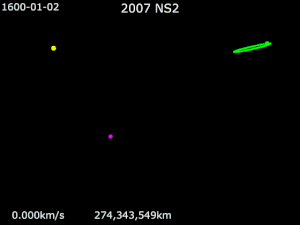2007 NS2
外观
| 发现[1] | |
|---|---|
| 发现地 | 萨拉天文台 |
| 发现日期 | July 14, 2007年7月14日 |
| 编号 | |
| 小行星分类 | Martian L5  |
| 轨道参数[2][3] | |
| 历元 2013年4月18日 (JD 2456400.5) | |
| 远日点 | 1.6060339 AU |
| 近日点 | 1.4413971 AU |
| 半长轴 | 1.5237155 AU |
| 离心率 | 0.0540248 |
| 轨道周期 | 686.9960633 d 1.88 yr |
| 平近点角 | 225.47063° |
| 轨道倾角 | 18.62167° |
| 升交点黄经 | 282.49888° |
| 近日点参数 | 176.93881° |
| 物理特征 | |
| 大小 | 800–1600 m |
| 绝对星等(H) | 17.8 |

太阳 · 2007 NS2 · 火星
2007 NS2是一颗位于火星后方60度的L5点上的一颗小行星。
发现、轨道和物理特征
[编辑]2007 NS2是在2997年7月14日被萨拉天文台(Observatorio Astronómico de La Sagra)发现的[4][5][6][7][8]。它的轨道特征是低离心率(0.054),中等程度的轨道倾角(18.6º)和1.52天文单位的轨道半长轴[8]。发现之后,被小行星中心归类为穿越火星者。它目前的轨道(2013年3月)是依据跨越4,800天弧长中的87次测量决定的[9]。2007 NS2的绝对星等是17.8,依据特征推断它的直径是870米[9]。
火星特洛伊和轨道演化
[编辑]Jean Meeus在2012年确认了Reiner Stoss在MPC数据库中从1998年起的轨道分析,怀疑2007 NS2是一颗火星的特洛伊小行星[10]。在2012年确认它是火星洛特伊的成员之一[11]。最近的计算确认这是一颗位于L5的稳定火星特洛伊,有着周期1,310年、振幅14º的摆动[12][13]。在所有已知的火星特洛伊,它有着相对于火星差距最小的半长轴,只有0.000059天文单位[12]。
起源
[编辑]长期的数值积分显示它的轨道在数十亿年的时间尺度下是非常稳定的。如同(5261) 尤里卡,计算显示无论在45亿年前或45亿年后,2007 NS2仍是原始的天体,或许它是在太阳系的早期历史中,在类地行星诞生与形成范围内幸存的微行星[12]。
火星特洛伊
[编辑]L4 :
L5 :
候选者:
参考资料
[编辑]- ^ Major News About Minor Objects. July 16, 2007 [April 22, 2009]. (原始内容存档于2019-08-06).
- ^ Template:Cite sbdb
- ^ AstDys-1. [2013-09-29]. (原始内容存档于2012-06-05).
- ^ 2007 NS2 discovery blog. [2013-09-29]. (原始内容存档于2020-07-24).
- ^ Discovery MPEC. [2013-09-29]. (原始内容存档于2016-03-04).
- ^ Update MPEC. [2013-09-29]. (原始内容存档于2013-10-03).
- ^ New Scientist article on the discovery. [2013-09-29]. (原始内容存档于2013-12-03).
- ^ 8.0 8.1 MPC data on 2007 NS2. [2013-09-29]. (原始内容存档于2016-03-03).
- ^ 9.0 9.1 JPL's Solar System Dynamics data on 2007 NS2
- ^ 存档副本. [2013-09-29]. (原始内容存档于2013-11-12).
- ^ Schwarz, R.; Dvorak, R. Trojan capture by terrestrial planets. Celestial Mechanics and Dynamical Astronomy. 2012, 113 (1): 23. Bibcode:2012CeMDA.113...23S. doi:10.1007/s10569-012-9404-4.
- ^ 12.0 12.1 12.2
de la Fuente Marcos, C.; de la Fuente Marcos, R. Three new stable L5 Mars Trojans. Monthly Notices of the Royal Astronomical Society Letters. 2013, 432 (1): L31–L35. Bibcode:2013MNRAS.432L..31D. arXiv:1303.0124
 . doi:10.1093/mnrasl/slt028.
. doi:10.1093/mnrasl/slt028.
- ^
Christou, A. A. Orbital clustering of Martian Trojans: An asteroid family in the inner solar system?. Icarus. 2013, 224 (1): 144–153. Bibcode:2013Icar..224..144C. arXiv:1303.0420
 . doi:10.1016/j.icarus.2013.02.013.
. doi:10.1016/j.icarus.2013.02.013.
- Further reading
- Rodriguez, J.; et al.. 2007 NS2. Minor Planet Electronic Circular. 2007: 2007–0303. Bibcode:2007MPEC....O...03R.
- Skiff, B. A.; et al.. 2007 NS2. Minor Planet Electronic Circular. 2007: 2007–O09. Bibcode:2007MPEC....O...09S.
- Schwarz, R.; Dvorak, R. Trojan capture by terrestrial planets. Celestial Mechanics and Dynamical Astronomy. 2007, 113 (1): 23. Bibcode:2012CeMDA.113...23S. doi:10.1007/s10569-012-9404-4.
- de la Fuente Marcos, C.; de la Fuente Marcos, R. Three new stable L5 Mars Trojans. Monthly Notices of the Royal Astronomical Society Letters. 2013, 432 (1): L31. Bibcode:2013MNRAS.432L..31D. arXiv:1303.0124
 . doi:10.1093/mnrasl/slt028.
. doi:10.1093/mnrasl/slt028. - Christou, A. A. Orbital clustering of martian Trojans: An asteroid family in the inner Solar System?. Icarus. 2007, 224 (1): 144. Bibcode:2013Icar..224..144C. arXiv:1303.0420
 . doi:10.1016/j.icarus.2013.02.013.
. doi:10.1016/j.icarus.2013.02.013.
